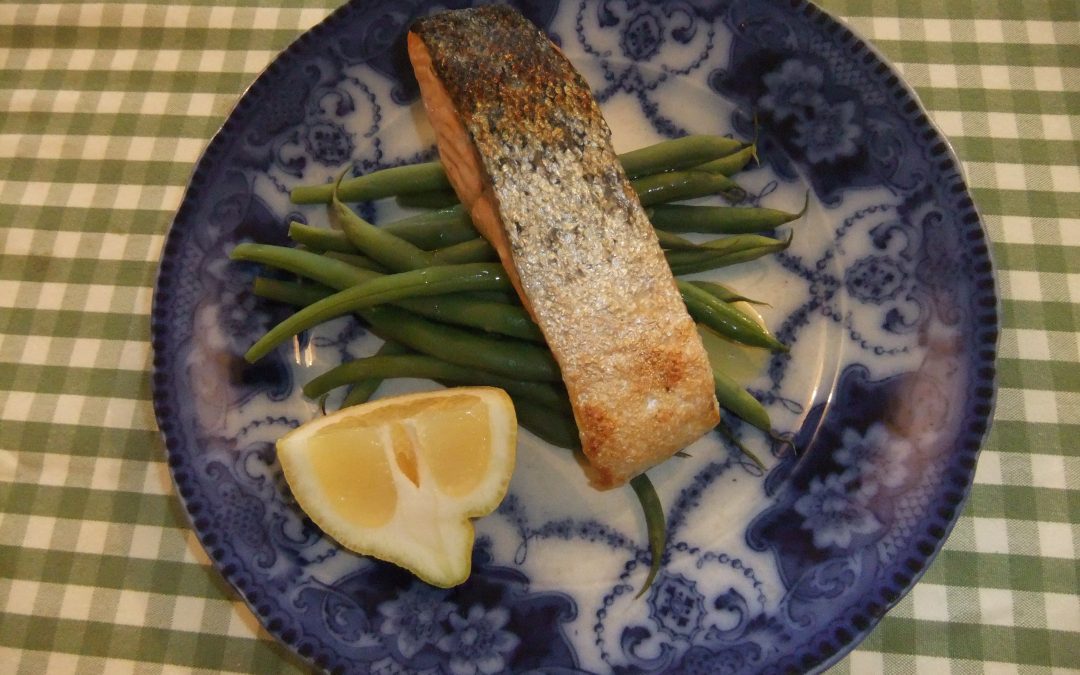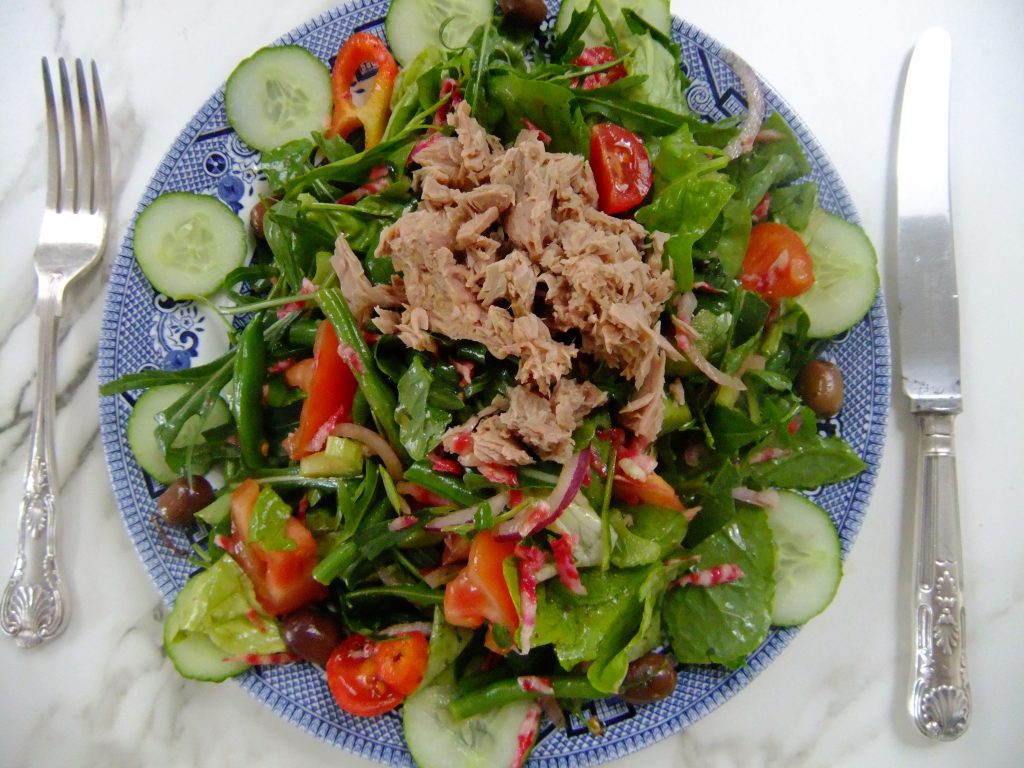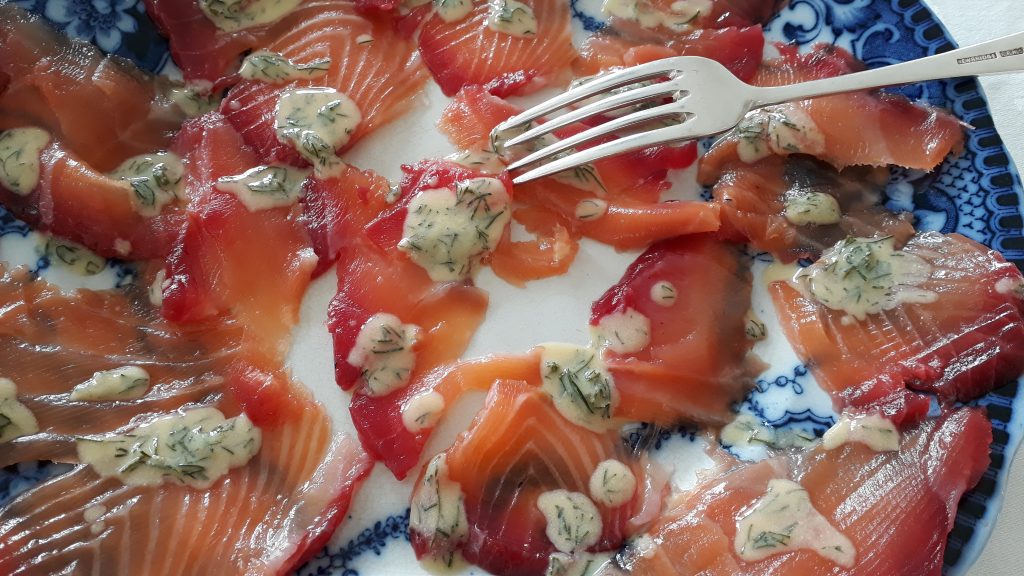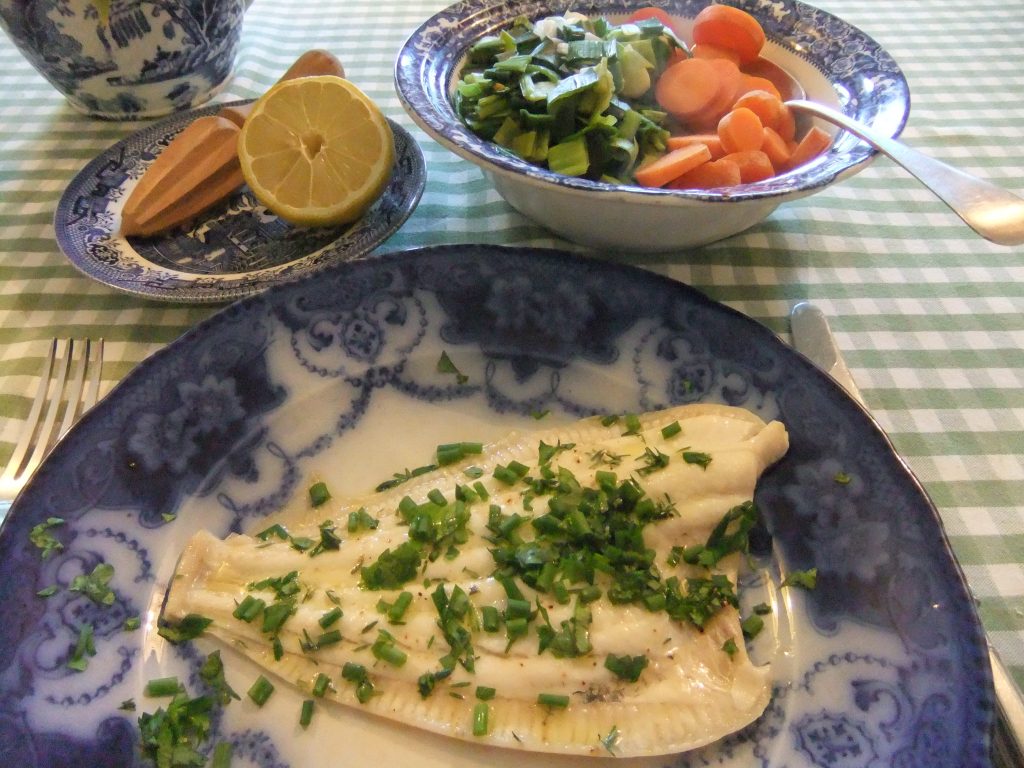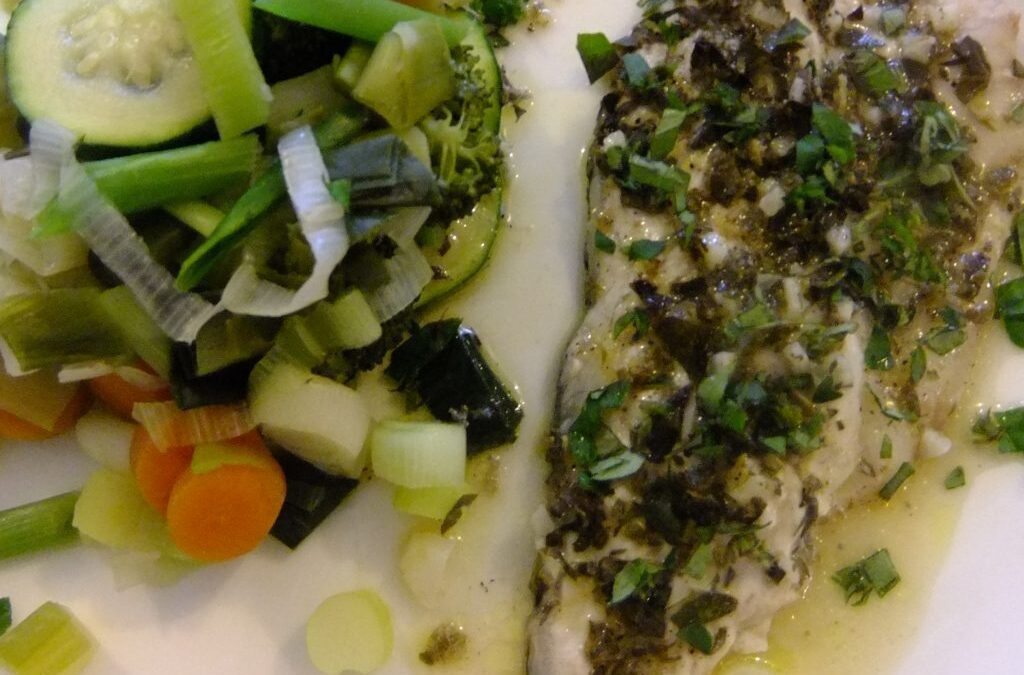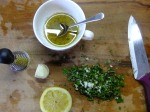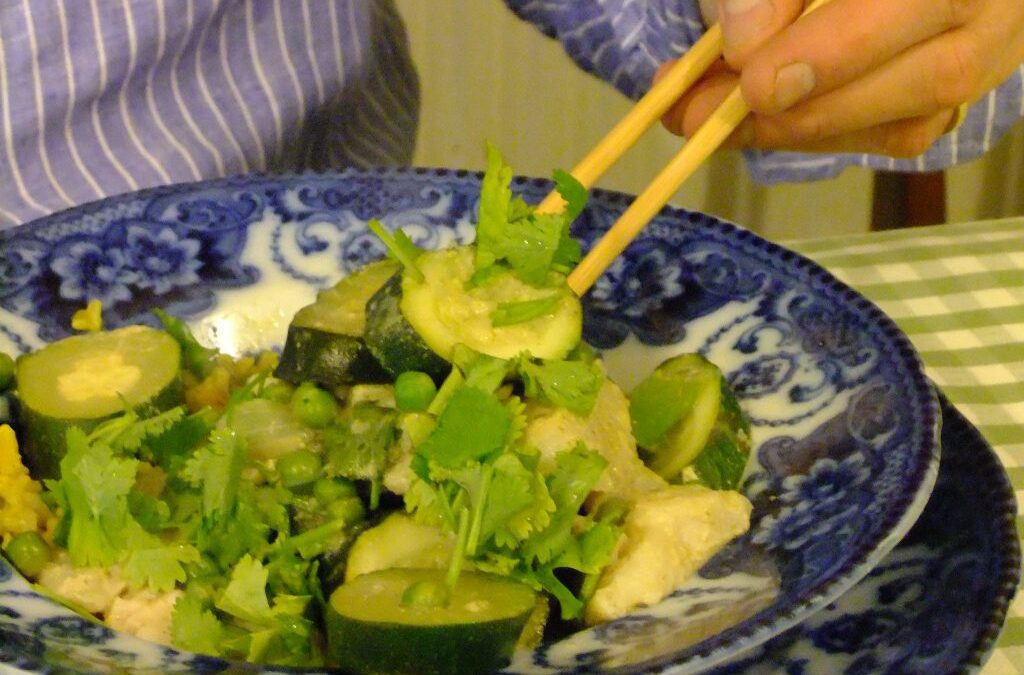
Apr 23, 2019 | Anna's Best Recipes, Main courses
This recipe is super-easy. It’s what I make when I come home late and want dinner on the table in 15-20 minutes.
For 2
2 salmon darnes/fillets/steaks, ideally wild or organic
A large clove of garlic, peeled and crushed
Tamari Sauce (see “larder & shopping” for where to buy)
1. Brush fish on both sides with the sauce, smear with the garlic.
2. Grill on medium heat for around 5 minutes flesh side up and 1-2 minutes skin side up until very slightly browned (watch it when grilling the skin side, it goes from not done to burnt very quickly).
Serve with:
- Steamed green or runner beans drizzled with fresh lemon juice or a large salad of mixed leaves, cherry tomatoes and sliced red onion drizzled with my home-made mediterranean or Asian salad dressing or a little fresh lemon juice and a glug of extra virgin olive oil. These accompaniments are suitable for a paleo (stoneage) or ketogenic eating diet.
- If you don’t want to lose any weight you could also add a medium steamed or baked sweet potato (just scrub, slice and steam with the skin on for extra nutrients) or some baby boiled white potatoes. Carbohydrates (grains, potatoes, sweet foods) are weight gainers.
Why this recipe is good for you:
Oily fish is a great source of omega 3 essential fats needed for weight management, beautiful skin and good brain function. Eating fresh rather than tinned fish is best because the plastic lining of tins contains bisphenol A (BPA). Fats in the food absorb BPA. BPA is linked by numerous studies to sex hormone imbalance (eg PMS, low libido, endometriosis, fibroids) and life-threatening diseases of the breast and prostate. Greens are a rich source of magnesium, which helps the liver clear natural and man made toxins from the body. common symptoms of magnesium deficiency include stress, wheezing in asthmatics, and sluggish bowels.

Apr 15, 2019 | Anna's Best Recipes, Main courses, Packed lunches
I love to eat a variation of this vitality-boosting salad for lunch most days. For a packed lunch put all the veggies including the garlic in a large lunchbox, store the dressing in a glass jar separately and put the fish or other topping in a glass or non-toxic container until ready to eat. The great thing about this is that because it doesn’t overload you with carbs (bread, grains, potatoes etc) you don’t tend to get that after-lunch sleepiness. For a change from tuna try a couple of boiled eggs, a cup of cooked butterbeans or beans (mixed with pesto and garlic) or a serving (80-100g) of smoked salmon or leftover roast chicken. Keep it interesting by changing around the types of leaves and the topping.
For 1:
Topping:
80-100g (half a large tin) tuna in spring water (or brine if you can’t get in water)
Salad:
1/2 a red/yellow pepper, de-seeded and sliced or cut in chunks
1 large vine tomato (cut in wedged) or 8 cherry tomatoes (halved)
1/4 red onion, sliced thinly
1/4 small cucumber or half a small courgette, sliced
A few black or green olives
2 large handfuls leaves (choose from baby spinach, lettuce, rocket, chicory, endive, watercress, landcress, pursalane, baby chard, flat leaved parsley leaves)
2 dessertspoons of home made extra virgin olive oil based dressing (see recipe on this blog)
1 small clove of garlic, crushed
Optional: half a cup of freshly grated raw beetroot or carrot
Optional: half a ripe avocado, cubed
1. In a large bowl mix all the salad ingredients with the dressing until everything is coated and glossy.
2. Pour out onto a plate, top with the tuna and enjoy.
Why this is great for you:
Did you know that eating lots of different plant foods every day is one of the most important things you can do for yourself. My guideline to patients is to try for 25 different plant foods (fruit, veg and beans/pulses) in the week. Each plant colour and type contains a different range of nutrients. Purple fruit and veg for example, contain proanthocyanadins, while orange and red plant foods contain carotenoids and green ones contain lots of magnesium. These are just some of the nutrients that help give you flawless (and young-looking) skin and hair, help repair and maintain your digestive system and keep you free of inflammatory conditions like eczema, asthma and digestive disorders like gastritis and colitis. Different plant foods feed different good bacteria to help you stay at your peak fitness and wellbeing. So its not just about eating large quantities of veg (half your plate at lunch and dinner) but large variety too. How many colours of fruit and vegetables can YOU eat today?

Jan 9, 2019 | Anna's Best Recipes, Main courses

Mustard-baked mackerel
This is is a super simple recipe I concocted today, inspired by a Nigel Slater recipe. Its ideal for a one-person dinner, or for a family. The mustard and lime lift the richness of the oily fish and are amazing for you too.
For 2:
2 fresh mackerel fillets
1 dsp coarse grain mustard
1 dsp fresh lemon or lime juice
Generous pinch black pepper
Pinch Himalayan salt/sea salt
1/2 tsp dried tarragon if you have it
A little olive oil to grease your roasting tin
To serve:
2 cupfuls sliced carrots
4 cupfuls broccoli florets
1. Heat your oven to 200C and while it is heating steam your vegetables and keep warm.
2. In a little bowl mix the mustard, pepper, salt, citrus juice and (if using) tarragon.
3. Oil your roasting tin, lay the fish skin side down, slather with the mustard mix and bake for 12-15 minutes. When the fish is done, it will no longer be translucent and the point of a knife or skewer will go through it easily.
4. Enjoy.
Why this is good for you:
We all know that omega 3 oils from wild mackerel are great for our brains and hearts. But did you know that having enough omega 3 affects every cell in your body – from helping you avoid diabetes (or get rid of it if you have it), to helping your body react efficiently to all your horrnones. Eating more oily fish is a no-brainer. Mackerel is one of the best oily fish as its always wild so its leaner and cleaner. Mustard is a spice and is powerfully antioxidant. It even helps prevent eczema breakouts. If you want a healthy brain and body for many many years to come, get the spices in to your everyday eating. Spices AND herbs (like tarragon) pack a powerful antioxidant punch to lower inflammation and help you age agelessly. And they liven up your plate. What’s not to like!

Dec 19, 2018 | Anna's Best Recipes, Main courses, Sides, starters, soups & snacks
This is a recipe I love. We eat it Christmas day with a simple salad of watercress and lambs lettuce. Instead of doing what the recipe says (wrapping everything in foil while it cures) I use a glass box with plastic lid to keep everything compressed during 5-8 days or curing. Much less fiddly. Lime zest/beetroot are optional but give an amazing taste and a lovely deep pink colour. Before you start, freeze the salmon for at least 24 hours to help kill any parasites. The salt, pepper and dill in the cure and the mustard in the sauce also help kill any unwanted visitors to your tummy!
For the cure:
1 large side of salmon, organic if possible, cut into 2 roughly equal shape pieces
Zest of 1-2 organic limes
1 large bunch fresh dill
115g sea salt/Himalayan salt – flakes or fine it doesn’t matter
50g coconut sugar (use brown sugar if you don’t have coconut)
75g xylitol or erythritol (from health shops)
15g freshly ground black pepper (coarse is OK)
Optional beetroot – 1 raw, grated (cooked might work too)
Tinfoil
For the sauce (to serve with the fish on the day):
1 tbs chopped fresh dill
1 tbs English mustard powder (if you don’t need gluten-free you can use ready-made English mustard from a jar)
1 tsp coconut sugar, erythritol, xylitol or brown sugar
1 tbs virgin (cold pressed unrefined) sunflower/peanut/rape/sesame oil
2 tbs kefir*, creme fraiche (for dairy-free use unsweetened additive-free soya yoghurt)
1 tbs white wine vinegar or apple cider vinegar
*home made fully-fermented kefir is usually tolerated by people with dairy sensitivity
1. For the cure (5-8 days before you want to eat the fish)
Roughly chop the dill and mix thoroughly in a bowl with the zest, salt, sugar, xylitol/sugar, lime zest, optional beetroot and pepper. Lay out a sheet of foil about four times the width of a salmon fillet. Spread a quarter of the pickling mix over a fillet-size area on one side of the foil with a good 15cm/6in margin for folding over.
2. Place one piece of fish, skin side down, on top of the pickle mixture and cover with slightly more than half of what is left. Place the second fillet on top, skin side up, to make a sandwich. Scatter the remaining pickle mixture over the skin. Wrap up the parcel tightly, tucking the ends and edges in underneath the fish.
3. Put the package on the tray and place a similar size tray, or a plank of wood on the top. Weight it down, with a brick or two or anything else handy (the contents of the fridge?). Turn the package daily for at least five days, and no more than eight. Do not discard the pickling liquid that oozes from the package unless it threatens to spill over the side of the tray.
4. At least one hour before you wish to serve the fish, combine all the ingredients for the dressing in a jar and shake well together. Leave to stand and shake again to emulsify before serving.
5. To serve, unwrap the gravalax and wipe off any excess pickling liquid. I like to scrape off the bits of dill and beetroot and give everything a quick wipe but you don’t have to. Slice fairly (but not too) thinly then serve with the sauce and a green side salad (I love watercress and lamb’s lettuce with this). Unused gravalax can be re-wrapped in clean foil or airtight glass box and kept in the fridge for up to five days.

Dec 20, 2017 | Anna's Best Recipes, Main courses
I was in a hurry last week and came up with this. Its super-fast on a weekday, provided you’ve already made up the Cajun spice mix (which only takes a couple of minutes). I’ve posted this mix already on the blog but its so good it deserves a reminder. I use it (when I remember) for grilling chicken fillets, salmon darnes and sometimes lamb chops. Rub the fish/meat with lemon juice first so the spice blend sticks on.
For 2:
2 hake fillets or darnes, about 160g each
Smoked paprika
Large bag of black kale (Cavolo nero) or curly kale
Sundried tomato paste, dairy-free red pesto (or if you are not dairy-free or on SC diet any good quality tomato pesto will do)
Fresh lemon juice (you will need about a teaspoon for the fish)
Extra virgin olive oil
Cajun spice mix:
You will need tinfoil and a roasting tin or dish
For the Cajun spice mix (store in an airtight glass jar away from heat and light)
½ level tsp chilli powder (omit or just use a pinch if you don’t like much heat)
1 level tsp Himalayan (pink) salt
½ tsp cayenne pepper
2 rounded tsp dried thyme
1 tbs each of:
Coarsely ground black pepper
Dried basil
Dried oregano
Ground coriander
Optional extra:
Cauliflower mash (see post) to serve
1. Turn on the oven to 200C.
2. Prepare the kale – wash, destalk and slice thinly. Boil your kettle and put the kale in your steamer over at least 2cm of boiling water. It can take quite a while to become tender.
3. While the kale is steaming, put the fish skin side down in an roasting dish with deep sides, rub the fish fillets with some lemon juice. Sprinkle Cajun mix and a good pinch of smoked paprika on each fillet until well coated.
4. Cover with tinfoil and give it 10 minutes in the preheated oven. After 10 minutes, test with a skewer to see if it is tender (this depends on the thickness of the fish). If not, give it another 5 minutes, covered again with the foil to stop the fish drying out.
5. Meanwhile, warm a vegetable dish for the kale. Into the dish put a generous heaped teaspoon of the pesto or paste, a dessertspoon of extra virgin olive oil and a good twist of black pepper if you have some. As soon as the kale is done to your liking toss with the pesto/paste to coat and keep warm.
6. Serve the fish on top of a pile of kale.
Optional extras:
Cauliflower mash (see blog post). This freezes well. I like to make a big batch then freeze leftovers in single portions. Reheat in a saucepan, stirring from time to time.
Why this is good for you
Herbs and spices are a powerhouse of vitality-boosting qualities. They protect the food during cooking from generating toxic inflammatory compounds (e.g. amines) while also protecting ourselves and our brains from accelerated ageing. Herbs and spices have hundreds of times stronger antioxidant properties than fruit and veg, weight for weight. Kale is a dark green leafy veg so its rich in magnesium and folic acid. We need both of these for making us more resilient to stress as well as for a healthy digestive system and good skin.

Oct 27, 2016 | Anna's Best Recipes, Main courses
This is another really quick dinner for when you don’t have a lot of time or inclination to cook. I never really liked flat fish much before seeing how Nigel Slater cooked it in his book, “Real Fast food”. Use plaice, sole or lemon sole, which will take a bit longer as it’s more robust. The same treatment is also lovely for fancy flat fish such as turbot or halibut, you will just need to cook the whole fish for longer, possibly in the oven.
The herbs aren’t crucial but they give massive health benefits (anti-inflammatory, gut-bacteria balancing, angi-ageing – the list is endless).
For 2:
2 sole or plaice fillets, about 160g each
Extra virgin olive oil – couple of teaspoons
About 1 dsp fresh thyme leaves
Optional: 3 heaped dsp chopped fresh/frozen parsley or scissor-snipped chives, or a mix of both.
A fresh lemon half, to squeeze over
Freshly ground black pepper
To serve: 6 cups steamed veg e.g. broccoli or runner/green beans OR 4 cups of greens and 2 cups steamed carrots or (not suitable for SC Diet) steamed slices of sweet potato. The orange veg give you more nutrients than in white potatoes.
1. Put your veggies in the steamer and keep warm when cooked.
2. Heat your grill to medium.
3. Brush a baking sheet or the shiny side of a large piece of tinfoil with a little olive oil and place on your grill rack, laying the fish, skin side down, on top.
4. Smear or brush the fish with the olive oil and sprinkle over the thyme leaves and a few good grinds of black pepper.
5. Grill till tender and opaque, about 5 mins. It’s done when the point of a knife goes through the fish like a hot knife through butter. The baking sheet/tinfoil helps cook the underside of the fish so you won’t need to turn it at all.
6. Manhandle the fish onto warmed plates using a fish-slice or spatula, and scatter over the parsley and/or chives.
7. Serve with the veg and a drizzle of extra virgin olive oil and hand around the lemon to squeeze over.
Variation:
You could use a small knob of butter, melted gently and brushed on, instead of the olive oil, if you want to, provided you don’t need a 100% dairy-free diet.
Why this is good for you:
White fish is a source of high quality protein that’s low in saturated fats. Herbs, especially fresh thyme, are a rich source of antioxidants that help lower inflammation in the skin (eg eczema), arteries (heart disease), and digestive system (eg. colitis, gastritis). Extra virgin olive oil, especially when eaten raw, is a great way to bump up your intake of vitamin E. Vitamin E moisturizes your skin from within. This vitamin also helps keep the blood thin, assisting circulation to the brain, hands and feet. Vitamin E has also been shown to play a part in dampening down an over-active immune system (e.g. allergies, auto-immune diseases).

May 20, 2015 | Anna's Best Recipes, Main courses
This dish is inspired by the flavours of Greece – fresh white fish, lemons, garlic and oregano. I saw a prepack product and thought “wouldn’t it be nice to make the fresh version”. It only takes a few minutes to get in the oven and is bursting with flavour and freshness. We enjoyed it with steamed leeks, courgettes and carrots sprinkled with some extra virgin olive oil.
For two:

Lemon, garlic, oregano for fish
2 x 160g sea bream or sea bass fillets
1/2 cup (about 100ml) white wine (or 4 tbs water and 1 dsp lemon juice)
1 tbs extra virgin olive oil or (if you want dairy) a knob of butter
Zest of 1 small lemon (organic or scrubbed with soapy water and rinsed)
1 clove garlic, crushed or finely sliced/chopped
Handful fresh oregano (about 5 x 12cm sprigs), stalks removed (if you don’t have fresh oregano you could use fresh tarragon or 1 tbs of chopped thyme leaves)
Freshly ground black pepper
1. Preheat the oven to 200C
2. Lay the 2 pieces of fish skin side down in a small roasting tin or ovenproof dish. 3. Pour over the wine (or water with lemon juice), the olive oil or butter and sprinkle on the lemon zest and garlic and a few good grinds of black pepper.
4. Chop the oregano. Reserve half for later and sprinkle half over the fish.
5. Cover the dish with tinfoil and seal the edges. Or use a close-fitting lid. The idea is that the fish steams in the liquid and stays succulent, rather than roasting and drying out. Bake for 8-10 minutes until the fish is cooked through.
6. Serve sprinkled with the remaining chopped oregano.
Serve with:
Any green vegetable. We like steamed leeks and broccoli. And optionally some carrots or carrot mash.
Why this is great for you:
Oregano and garlic can help supercharge your health and vitality. They both act against overgrowths of disease-causing bacteria and yeasts in your gut. The bacteria that live in your gut outnumber the cells of your body 10 to one and they have a massive impact on mental and physical health. Not having enough good bacteria, or an overgrowth of bad is a major factor in skin conditions and digestive troubles. If you take antibiotics, eat food with glyphosate (herbicide) residues, or eat a high carbohydrate diet, your gut bacteria will not be all they should be. Garlic and oregano can help start to set things right. Garlic, oregano and lemons also contain anti-ageing, anti-inflammatory compounds that protect your brain and your joints and slow down the accumulation of wrinkles. Unprocessed white fish is a good source of high-quality protein. Protein is needed for helping us eliminate natural and man-made toxins. If you team the protein up with (more than half your plate) greens and multicoloured veg you have a winning formula for energy and vitality.

Mar 11, 2015 | Anna's Best Recipes, Breakfasts & smoothies, Main courses
This is a great breakfast (or any meal) and is super fast. The kippers are left to stand in boiling water for a few minutes while you grill the courgettes and tomatoes, simple…
I like to remove the skin of the kipper before cooking because otherwise it causes the fish to curl up unattractively. But if you don’t care about that, don’t bother. You could also have the lovely vegetables more simply with a small smoked mackerel or trout fillet – no need for the pan of water.
1 small kipper (smoked herring) fillet, skin removed with a sharp knife
1 medium courgette, sliced lengthways into strips around ½ cm thick
2 medium tomatoes, halved, woody bit removed
Extra virgin olive oil
1 teaspoons dried oregano
Freshly ground black pepper
1. Boil the kettle. While the kettle is heating up place a small pan on a medium heat to warm before putting in the kipper and pouring on enough boiling water to cover. Take off the heat and leave to poach in the hot water for about 3 minutes.
2. Meanwhile heat the grill. Place the courgettes and tomatoes on a baking sheet or on the grill rack and cook until just softened. You are not looking for everything to be squishy, just heated through and softened slightly.
3. Arrange on a plate, sprinkle with olive oil to taste and scatter the dried oregano over the tomatoes.
4. Serve with the kipper.
Why this is good for you:
Kippers are smoked herrings. Because herrings are a wild cold water fish, they are rich in essential omega 3 fats you need for healthy skin and hair. Omega 3 helps prevent your blood from clotting too much and this helps bring more blood and nutrients to the whole of your body. Oregano, even dried, is high in antioxidants (provided you store it away from light and air) and has anti-fungal, anti-yeast and anti-microbial properties against bad bacteria in your gut. “Bad” bacteria and yeast are a major cause of skin problems and weight issues. They can be lowered, and good bacteria encouraged, by what you eat every day. Tomatoes and courgettes are a rich source of beneficial fibre and (more) antioxidants, which protect our bodies from inflammation and delay the ageing process. This breakfast is very light on carbohydrates (sugars) and free from grains so its super-healthy.

Feb 4, 2015 | Anna's Best Recipes, Main courses
This is gorgeous and super fast. I love this on a weekday when I come in late, hungry and don’t feel like spending more than 15 minutes cooking dinner. It works beautifully for small fillets/darnes of chicken, hake, salmon, or cod and I have used it for lamb chops too. Yum! Make up more then you need and store in an airtight jar somewhere dark, so it keeps its precious volatile oils and flavours.
For two:
1/2 tsp chilli powder (or a whole teaspoon if you use very mild chilli)
1 tsp Himalayan or Atlantic Sea Salt
½ tsp cayenne pepper
2 tsp dried thyme
1 tbs each of:
Coarsely ground black pepper
Dried basil
Dried oregano
Ground coriander
2 x small (100g) chicken fillets, 130g-150g darnes/fillets of salmon/white fish or 4 lamb centre loin chops
For cooking:
Juice of 1/2 freshly squeezed lemon (or a little olive oil if you don’t have lemon)
- Mix everything well and store in an airtight jar away from light and heat until ready to use.
- When you want to cook the meat or fish, pour some of the spice blend onto a plate. Rub with a little lemon juice on your meat/fish. Dip/roll the meat or fish in the spice mix until totally coated on all sides.
- Cook in the oven on an oaked baking sheet or under the grill.
Oven: 1/2 an hour at 180C for small chicken fillets, 15 minutes for fish fillets
Grill: Around 7 minutes each side for chicken or around 3-4 minutes each side for fillets or darnes of salmon, hake or cod.Serve with:
2-3 cups steamed broccoli, green beans, runner beans or peas per person, dressed with a generous drizzle of extra virgin olive oil or a knob of coconut oil.
A large mixed salad of green leaves, sliced red onion, cherry tomatoes and sliced cucumber or courgettes, dressed with one of my salad dressings from this blog.
Why this is good for you:
Herbs and spices are a fantastic way to get even more taste and vitality into your day. They are antioxidant, anti inflammatory, heal the digestive system (chillies can help heal ulcers!) and keep you younger longer by holding back the ageing process. Many help alleviate skin conditions by supporting your liver function. Black pepper contains piperine, a substance that increases your ability to absorb vitamins and minerals in the meal. Herbs and spices contain tens or hundreds of times more antioxidants than fruit and vegetables, weight for weight. Vegetables (and small amounts of fruit) are still a powerhouse for wellness but don’t forget the herbs and spices.

Jan 3, 2015 | Anna's Best Recipes, Main courses
We had this for dinner last night – what a lovely change after all the festive overindulgence….
This recipe is great with fillets of lemon sole or monkfish. You could also use cod or hake though these do have a tendancy to break up more easily (so don’t stir during cooking or they will go to mush). Thai Curry paste from Western companies like Sharwoods is less hot then that from Asian shops so choose whatever you prefer. This recipe is also good made with shelled king prawns which can be cooked from frozen (but don’t cook for more than a few minutes or they will become tough!).
For two:
2 medium white fish fillets (about 130-150g each), skinned and cut into bite sized cubes
1 large onion, roughly chopped or a bunch of spring onions, cut in 2cm lengths
200g frozen peas (for alternative, using courgettes, see below)
2 cloves garlic, crushed or chopped
2-3 teaspoons Thai green curry paste (or yellow/red if you don’t have green)
1 small tin coconut milk (165ml tin from Asian shops/good supermarkets)
Juice of 1 small lime (or use the juice of half a lemon)
2-3 heaped tablespoons chopped fresh coriander if you have it
Optional: 1 dsp of Thai fish sauce
1. In a wide bottomed saucepan or frying pan on a medium heat mix the coconut milk, curry paste, and fish sauce if using, and stir until smooth
2. Add the onion and cook, covered, till softened (about 8-10 mins for white onions, about 3 minutes for spring onions).
3. Add the garlic, peas (breaking the lumps up), courgette if using, and fish to the mix in the pan and stir well to coat everything in sauce. If the mixture looks a little less saucy then you would like or looks like drying out, add a tablespoon of water (the fish will give off liquid during the cooking too).
4. Cover with a lid or a plate simmer for about 5 minutes until the fish is opaque.
5. Squeeze over the lime (or lemon) juice, and sprinkle on the coriander.
Serve with:
Low carb or SC Diet: https://annacollins.ie/cauliflower-rice/
OR
Grains (not suitable for SC Diet):
Brown basmati or long-grain rice cooked with ½ teaspoon of turmeric to give a beautiful golden colour.
100% buckwheat noodles (Health stores/Asian shops)
Variation:
We ran out of peas the other night and used a couple of large courgettes instead. Sliced into 1cm disks and added 5 mins after the onions, they are delicious too.
Ketogenic diet option:
Avoid using the peas and instead use courgettes, and don’t use rice or noodles instead. As a cheat, you could use “zero” or “slim” noodles from Asian shops or health stores, which are made from konjac. Konjac helps feed good bacteria in your gut, which can aid weight loss. Konjac is not absorbed or digested by your body, so they effectively have zero calories!!
Why this is good for you:
Herbs, spices (in curry paste) and garlic give a huge boost to your health, helping detoxification, reducing inflammation and delaying ageing (great news for any of us over 30!). If you want beautiful, clear skin and a healthy digestive system, cooking daily with herbs, garlic and spices is a winner. All green vegetables are rich in magnesium, which also helps us to relax, sleep well and feel upbeat. Coconut milk is high in good fats called medium chain triglycerides which are great for energy, being burned off by your body instead of being stored in fat cells. Coconut also contains lauric acid and caprylic acid, both of which help prevent excessive yeasts and “bad” bacteria in your gut. Coriander helps bind (and safely remove) toxins in your digestive system, especially mercury which you ingest (every time you eat) if you have old-fashioned silver-coloured dental fillings. Cooking at low temperatures like this (100C or less), instead of frying or roasting, keeps more nutrients in your food too.
